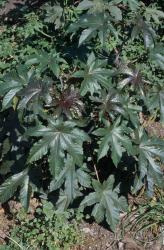- Taxon
- Weed
- Gallery
Erect, ± glabrous, shrub up to 4 m high (in colder areas as an annual herb). Stems rounded, smooth or slightly ribbed, softly woody. Lvs alternate, deltate, deeply palmately 5–9-lobed (first few lvs opposite and shallowly lobed); lobes acute to acuminate, irregularly serrate; petiole somewhat > or ± = blade; seedling lvs 6–12 cm diam.; adult lvs 20–40 cm diam.; young lvs with deciduous stipules. Panicle erect, with ♂ fls below, ♀ above; bracts subtending panicle-branches ovate-triangular, entire, deciduous. Pedicel elongating at fruiting; capsule deeply grooved between cells, usually covered in long soft spines, rarely without spines. Seeds rectangular, usually mottled brown or grey, c. 15 mm long.
[From: Webb et al. (1988) Flora of New Zealand. Volume 4.]




